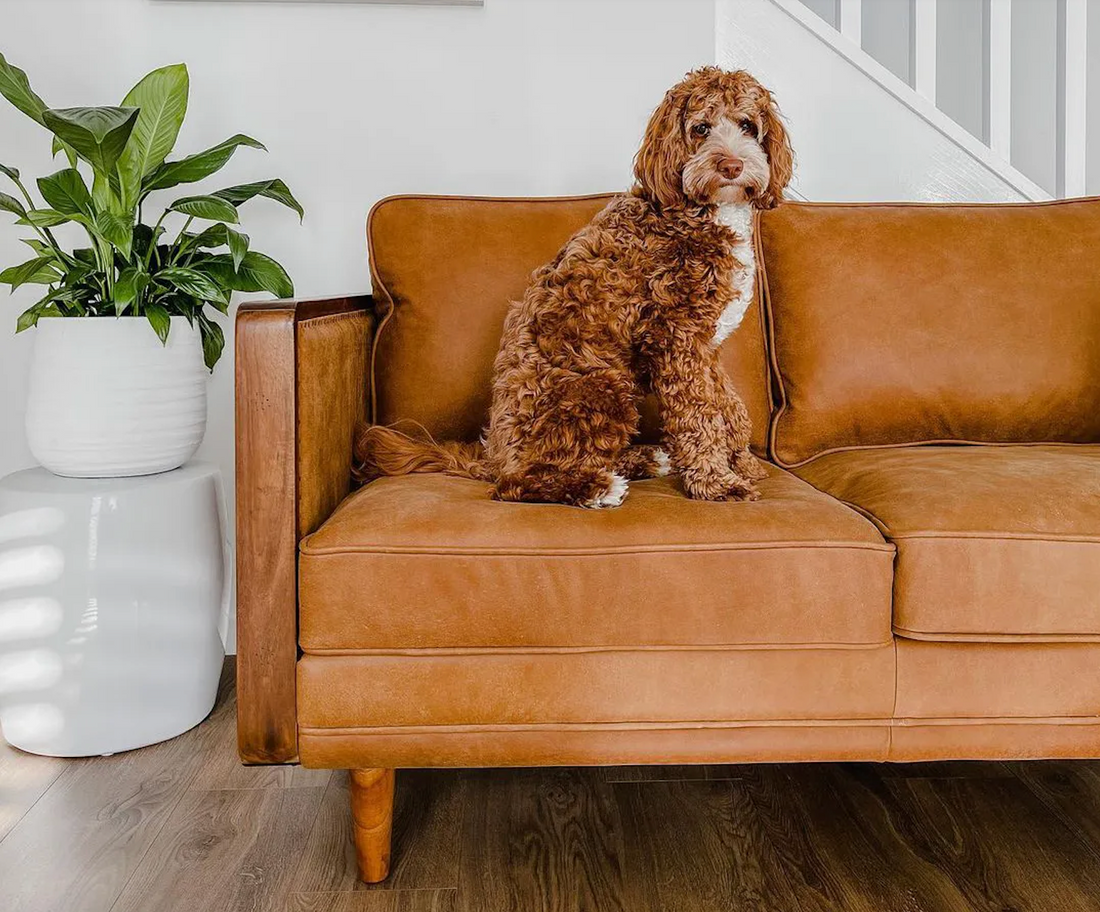When creating a comfortable and stylish home for both you and your furry friends, one question often arises: is leather sofa pet-friendly? As more pet owners seek durable and easy-to-clean options, pet-friendly leather furniture has gained popularity in interior design. To clarify this, COZY will delve into the characteristics that make leather sofas a potential fit for pet-friendly environments, examining their resilience, maintenance needs, and overall suitability for homes shared with beloved animals.
Pros of Leather Sofas for Pet Owners
Leather furniture offers practical benefits for homes with pets, especially for dog owners, and it remains a popular choice for those looking to maintain an appealing and hygienic home environment.
Pet Hair Management
Unlike fabric upholstery, leather doesn’t trap hair in the material, making it much easier to manage pet hair. Pet fur naturally slides off leather, making it ideal for households with shedding pets.
With leather, pet owners can simply use a cloth or a damp wipe to gather hair and remove it. Unlike fabric couches, which may require multiple passes with a vacuum, leather saves time and effort.
Because hair doesn’t get embedded into leather, pet owners won’t need to invest in special vacuum attachments or pet hair removal gadgets. Leather provides a convenient, low-maintenance solution.
Leather sofas help reduce the time spent on hair cleanup, which is a big plus for busy pet owners. This low-maintenance quality is a key reason why recommended leather couches for dog owners are highly valued.
Handling Pet Messes
Leather is non-porous, so when a spill or accident occurs, it doesn’t seep into the material, allowing for a simple wipe-down.
Leather sofas don’t hold onto pet smells in the same way that fabric does, a major benefit for pet owners. This characteristic plays a huge role in eliminating pet odors from furniture, keeping the living space fresh.
Treated leather is highly resistant to stains from pet saliva, dirt, or mud. Pet messes are easy to clean up without leaving marks.
Leather that’s been treated with protective coatings becomes even more waterproof, adding to its resilience against spills and accidents. This protection is particularly valuable in pet households.
Durability with Pets
High-quality leather sofas are built to endure. Unlike fabric, leather won’t fray, making it more suited to withstand the wear and tear of pets over the years.
While no material is entirely scratch-proof, leather is less likely to show signs of everyday pet scratches compared to fabric, which can easily snag or tear.
Unlike woven fabric that can get caught on claws, leather remains smooth and doesn’t snag. For dog owners, this feature is essential in keeping the sofa looking pristine.
Many leather sofas are built with durability in mind, which means they can hold up to pets who enjoy jumping or lounging on the couch without quickly wearing out.

Leather furniture is a practical choice for pet-friendly homes, especially for dog owners, as it combines durability with easy maintenance, helping to keep the home attractive and hygienic.
Pet-Related Concerns
Many pet owners wonder, is leather sofa pet-friendly and is leather sofa good for dogs, and while there are undeniable benefits, addressing potential drawbacks is essential for making an informed decision.
Scratch Risk
While leather is known for its resilience, pets’ claws, especially cats’, can still scratch the surface. High-quality leather tends to resist scratches better, but scratches are still possible.
Pets who aren’t trained may see furniture as fair game. This can be especially challenging for cats, as scratching is a natural behavior. Repairing scratches from cats is possible with leather repair kits, but prevention is key to keeping leather looking fresh.
Cats, in particular, are drawn to scratching textured surfaces. Unlike fabric, leather doesn’t pull or shred as easily, but cats may still enjoy digging their claws into it, leading to visible scratches.
Lower-quality or bonded leather is more susceptible to damage from pets’ claws than high-quality, full-grain leather. Investing in durable, pet-friendly materials can make a big difference in preventing unwanted damage.
Bite and Chew Issues
Puppies going through teething phases may find leather appealing due to its texture. This can lead to significant damage if the behavior is left unchecked.
Some pets, especially dogs, may chew on leather edges or seams when feeling anxious. This behavior not only damages the sofa but can also pose a health risk if they swallow pieces of leather.
Fixing chewed or bitten leather can be costly. Pet owners should be aware of the potential for expensive repairs, especially for high-end furniture, as leather repair isn’t always simple.
Due to its scent or texture, some pets may confuse leather furniture with chew toys. Ensuring pets have appropriate toys and protective measures for pet furniture, such as corner covers or pet deterrent sprays, can help reduce this risk.
Pet Comfort
Leather tends to stay cooler than fabric, which can make it uncomfortable for pets to sit on during colder months. Adding a blanket or a pet bed on the couch can help make it more inviting.
Leather surfaces can be slick, making it difficult for pets to find grip. Older pets or those with mobility issues may find it challenging to get comfortable on a leather sofa. Some owners choose to use throw blankets or cushions to help pets stay in place.
Leather can feel sticky and uncomfortable in warmer conditions, which may lead some pets to avoid the sofa altogether.
Pets can be sensitive to texture, and some might simply prefer softer, fabric-covered surfaces. This varies by pet, but understanding their preferences can help in choosing the right furniture materials.

While leather offers undeniable benefits, it's essential to consider potential drawbacks to make an informed choice.
Making Leather Work with Your Pets
Leather can be a stylish and practical option for pet owners, but keeping it in good shape requires some proactive steps. Here are some essential strategies, including effective pet hair removal techniques, that can help make leather work in a pet-filled home.
Train Your Pets
Establishing clear rules on where pets can and cannot go is the first step in protecting your leather furniture. Training pets to avoid the sofa entirely or allowing them on it only with supervision can make a big difference in preventing scratches and stains.
Using barriers like pet gates or covers on furniture during the training period can help reinforce boundaries. These barriers serve as visual cues for pets, making it easier to teach them which areas are off-limits.
Choose Smart
When choosing leather, opt for top-grain or protected leather, as they are the most durable pet-friendly materials available. Protected leather is treated with a coating that adds resistance to scratches and stains, making it ideal for households with pets.
Semi-aniline leather strikes a balance between aesthetics and practicality. It has a light protective coating, allowing it to resist stains and scratches better than aniline leather while retaining a natural appearance. This protection enhances its pet-friendliness without sacrificing style.
Darker leather tones are particularly useful in pet homes because they mask minor scuffs, scratches, and pet hair. Even if some wear occurs, dark leather helps it remain less noticeable, maintaining a cleaner look over time.
Protect Your Investment
Leather protectants are available to coat surfaces and protect them from pet scratches, spills, and other damage. Applying a leather conditioner or protective spray to high-contact areas helps maintain the leather’s resilience and luster.
Regular nail trimming is an essential preventive measure to protect leather from scratches. Trimming pets’ nails minimizes the chance of accidental scratches, particularly when pets jump onto the sofa.
Leather can fade and weaken when exposed to direct sunlight for extended periods. Placing the sofa in a shaded area can help maintain its color and durability over time, especially if it’s frequently used by pets.
Leather can become warm and sticky during the summer, making it uncomfortable for pets and more prone to wear. A lightweight throw blanket not only helps pets feel more comfortable but also provides a protective layer, reducing direct contact with the leather.
Real leather is durable and resilient, often standing up well to the wear and tear of pet claws, while is faux leather pet friendly depends on its specific material quality and coating. Many pet owners also wonder, is leather sofa pet-friendly, and the answer generally leans toward yes, with the right care and maintenance. At COZY, we offer a range of quality leather sofas designed to withstand the rigors of daily life with pets, ensuring that you can enjoy both comfort and durability. Explore COZY’s collection to find the perfect leather furniture that complements your lifestyle and keeps both you and your pets comfortable.





